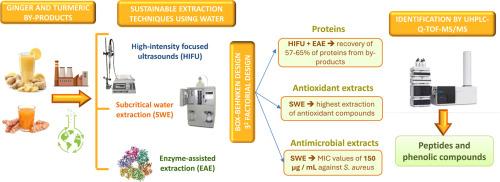利用可持续提取技术从姜黄(Curcuma longa)和姜(Zingibber officinale)废料中回收蛋白质和生物活性化合物。UHPLC-Q-TOF-MS/MS对主要提取物进行初步鉴定
IF 6.5
Q1 CHEMISTRY, ANALYTICAL
引用次数: 0
摘要
生姜和姜黄由于其出色的成分和健康益处而越来越多地用于果汁生产。这种做法产生的废物,就像整个香料一样,可能构成廉价和可持续的蛋白质来源,以及抗氧化和抗菌化合物,其回收尚未提出。这项工作旨在评估低环境影响技术,以充分利用这些废物:高强度聚焦超声(HIFU)、亚临界水提取(SWE)和酶辅助提取(EAE)。在所有情况下,均使用水作为提取溶剂,并采用实验设计化学测量工具(Box-Behnken和析因32设计)来最大限度地回收蛋白质、抗氧化剂和抗菌化合物,同时最大限度地减少提取过程中潜在有害美拉德产物的形成。HIFU显示出更大的蛋白质提取能力,当使用多糖酶与EAE联合使用时,蛋白质提取能力显著提高。在60ºC和80%振幅下,HIFU作用18 min,结合使用Celluclast酶的EAE,从姜提取物中提取的蛋白质最多。SWE提取的提取物具有显著的抗氧化活性,当使用2个周期而不是1个周期时,其抗氧化活性略有提高。从姜黄废料中提取的抗氧化活性最高,SWE在175℃下加热15 min。该提取物还显示出抗菌活性,特别是对金黄色葡萄球菌,突出显示姜黄废物提取物在155ºC下使用SWE处理9分钟(0.15 mg/mL)获得的最低抑制浓度。采用高效液相色谱联用高分辨率串联质谱法对抗氧化或抗菌活性最高的提取物进行了分析,初步确定了主要活性成分。初步确定了生姜提取物中的6-姜辣素及其衍生物和姜黄素等酚类化合物为主要成分。本文章由计算机程序翻译,如有差异,请以英文原文为准。

Recovery of proteins and bioactive compounds from turmeric (Curcuma longa) and ginger (Zingibber officinale) wastes using sustainable extraction techniques. Tentative identification of main extracted compounds by UHPLC-Q-TOF-MS/MS
Ginger and turmeric are spices increasingly employed in juice production due to their outstanding composition and health benefits. This practice results in wastes that, like whole spices, likely constitute a cheap and sustainable source of proteins, as well as antioxidant and antimicrobial compounds, whose recovery has not yet been proposed. This work aims to evaluate low environmental impact techniques to make the most of these wastes: high-intensity focused ultrasounds (HIFU), subcritical water extraction (SWE), and enzyme-assisted extraction (EAE). In all cases, water was used as extracting solvent and experimental design chemometric tools (Box-Behnken and factorial 32 design) were employed to maximize the recovery of proteins, antioxidants, and antimicrobial compounds, while minimizing the formation of potentially harmful Maillard products during extraction. HIFU demonstrated a greater capability for extracting proteins, which increased significantly when combined with EAE using a polysaccharidase enzyme. The largest protein extraction was achieved from the ginger extract using HIFU for 18 min, at 60 ºC and 80 % amplitude, combined with EAE using Celluclast enzyme. The extracts obtained using SWE showed significant antioxidant activity, with a slight improvement observed when using 2 cycles instead of one. The highest antioxidant activity was observed in the extract obtained from the turmeric waste using SWE at 175 ºC for 15 min. The extracts also exhibited antimicrobial activity, especially against Staphylococcus aureus, highlighting the minimum inhibitory concentration obtained from the turmeric waste extract using SWE at 155 ºC for 9 min (0.15 mg/mL). The extracts showing the highest antioxidant or antimicrobial activity were analyzed by ultrahigh-performance liquid chromatography coupled to high-resolution tandem mass spectrometry for the tentative identification of main compounds responsible for the observed activities. Phenolic compounds, such as 6-gingerol and its derivatives in ginger waste extracts, and curcuminoids in turmeric waste extracts, were tentatively identified as the predominant constituents.
求助全文
通过发布文献求助,成功后即可免费获取论文全文。
去求助

 求助内容:
求助内容: 应助结果提醒方式:
应助结果提醒方式:


